Population: Decline, Growth, and Stagnation
Population. It is the most basic measurement of a city, without population you cannot calculate density. Some threshold of density is what creates a city. Thus trends and shifts of a city's population are the background music which plays through the entire story of a city.
We all know the story of cities like Detroit, once in the league of present day Chicago, which then collapsed to just over a third of its once-upon-a-time glory. The same story can be told of many smaller cities across the midwest; such as Gary, IN falling from ~180,000 citizens - roughly the size of Grand Rapids in 1980s - to barely 70,000 citizens in 2020 - roughly the size of Grand Rapids in the late 1890s. As it is citizens - and the resulting density - which creates a city, decline is painful; a city which looses population, whose density declines, is a lesser place.
The currents which create decline are numerous: racism ("white flight"), urban de-industrialization, public policy (urban renewal), infrastructure (the decline of the railroads as the public's money is pumped into sprawling highways), and old fashion vibes followed by their subsequent dissipation (post-pandemic Austin, TX). Often pundits will play a game of choose one, but the truth is that any city's decline is a personalized mix of all-the-above.
Aside: Yes, all the above - racism, de industrialization, infrastructure, and even vibes - are all ultimately public policy. Electing government based on vibes rather than competence, or some demonstration a candidate has recently read a book, is the story under the all the [true] stories told about a republic.
Those stories of the urban decline of American cities are too often treated as a kind of universal story. This is not true. Many cities have never experienced pronounced decline, and many have grown significantly in recent decades. New York city, America's true capital, has experienced only one decade of population decline (1970s) in its entire history and has since rebounded to 20% greater - 1,400,000 more citizens - than its low point (~1980).
Aside: If you consider the numbers the hyperbolic stories told about New York city during the COVID pandemic - about an "exodus" from the city - it brings into question the basic competency of the authors. Imagine some Moses like figure leading out of New York city a caravan equivalent to the population loss Detroit experienced in the mid-20th century (2/3rds of its population). That would be ~5,250,000 people. Setting out into a nation already a decade into a pervasive "housing crisis" . . . where the %^&@%$^&$ did those pundits believe those people were going to? If such an exodus occurred, or even a fraction of such an exodus, it would have completely overwhelmed the housing market of every metropolitan area in America. The notion that such a thing was happening was astonishingly stupid. Not all stories are true, some stories are not even plausible.
And where is Grand Rapids, MI in all these stories? Grand Rapids is the little city that could. There has been no period of pronounced and sustained population loss. Beginning in the early-middle 20th century the story of Grand Rapids' population has been remarkably stable, with a gentle upward trend-line.
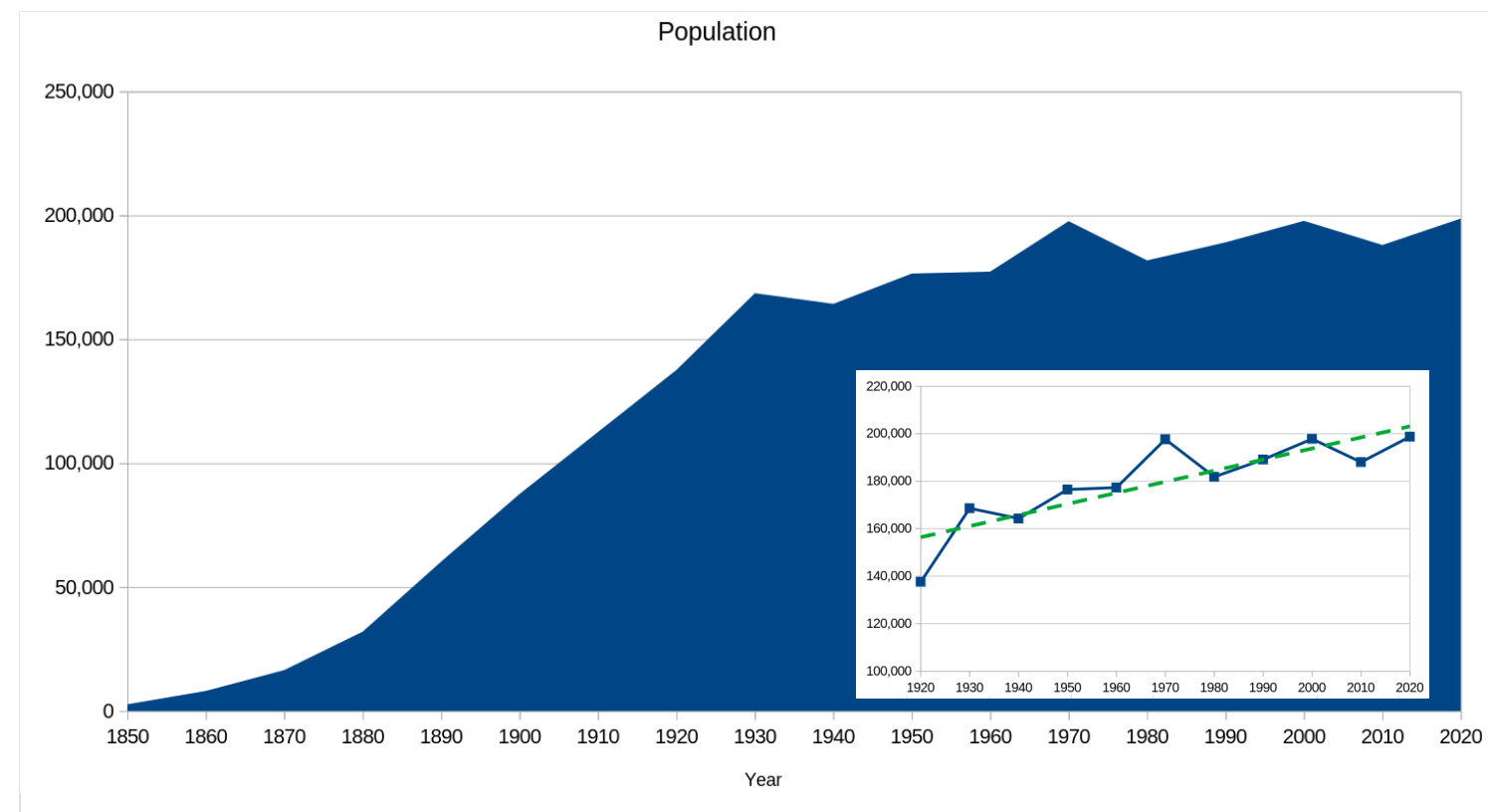
This chart always amuses me. I am Gen-X, and during the period of my youth the story of the pervasiveness of America's urban decline was accepted by nearly everyone. From my own family, to Michigan's then governor James Blanchard (D), and even amoung city leaders. The last person to leave the city should please remember to turn off the lights. Yet, there in the data: not many people actually leaving. The profound falsehood of that story, and the people who blithely accepted it, is something I think about frequently.
There is some drama related to Grand Rapids's population counts. There was a census population estimate for 2019 of 201,013. This put the city over the rhetorically significant threshold of 200,000 citizens. The 2020 census completed with a number of 198,917. This would be a +5.78% increase over the 2010 census of 188,040 citizens; yet below that rhetorically significant threshold. Census estimates had placed the city over that threshold as early as 2018. The city objected and filed a challenge to 2020 census count, resulting in more than 1,600 new citizens being added to the count.
And now, what about the future? In 2020 the Housing Next report was announced with much fan-fare [and scant subsequent policy]. Within that document was a projection that, in 2024, Grand Rapids' population would be 212,146. That would have been a strong +4.4% population growth.
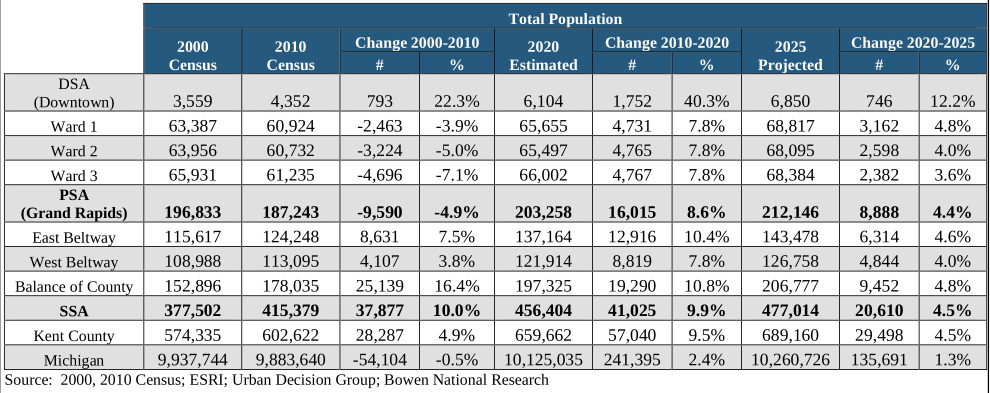
Housing Next 2020: Population & Population Projection
And where are we? Still stuck somewhere just over that 200,000 number. In the Housing Next update in 2022 the leveling of growth appears in the numbers. Five year growth estimates were trimmed to +1.1%.

Housing Next 2022: Population & Population Projection
And then the 2025 Housing Next update revised population growth down even further. To less than 1%.

Housing Next 2025: Population & Population Projection
So, here we are in 2025, likely with just over 200,000 citizens and looking at dramatically reduced growth projections. It is a strong contrast to only ~5 years ago's +4.4% growth estimates. Importantly, this is not decline, it is still growth however anemic.
- New County Population Estimates, UrbanGR 2025-03
What happened?
Many people will want to jump on the pandemic as an explanation; that's easy, and there is - conveniently - little anyone can do about it. What a useful narrative for the powers-that-be...
There is also the state's flat-line population; being tethered to the bi-partisan incompetence and apathy of Lansing makes any Michigan city akin to a boat dragging anchor. The brief Democratic Trifecta (2022 - 2024) managed to deliver nothing for Michigan's cities; it provided a brief period of hope, before degenerating into a pen of squabbling hens.
Urban growth in America has always been underwritten by immigration. Migration to the United States is, without question, a driver of population growth, urban vitality, and economic prosperity. The collapse of the federal government and the new regime's absurdist xenophobia has largely closed the doors to America. Our cities will bear the greatest share of the cost of the new government's policies; with Grand Rapids as no exception.
It is all quite depressing. On the state and federal stage there is a quietude, a deafening absence of champions. It feels as though this new season will be long, perhaps generational.
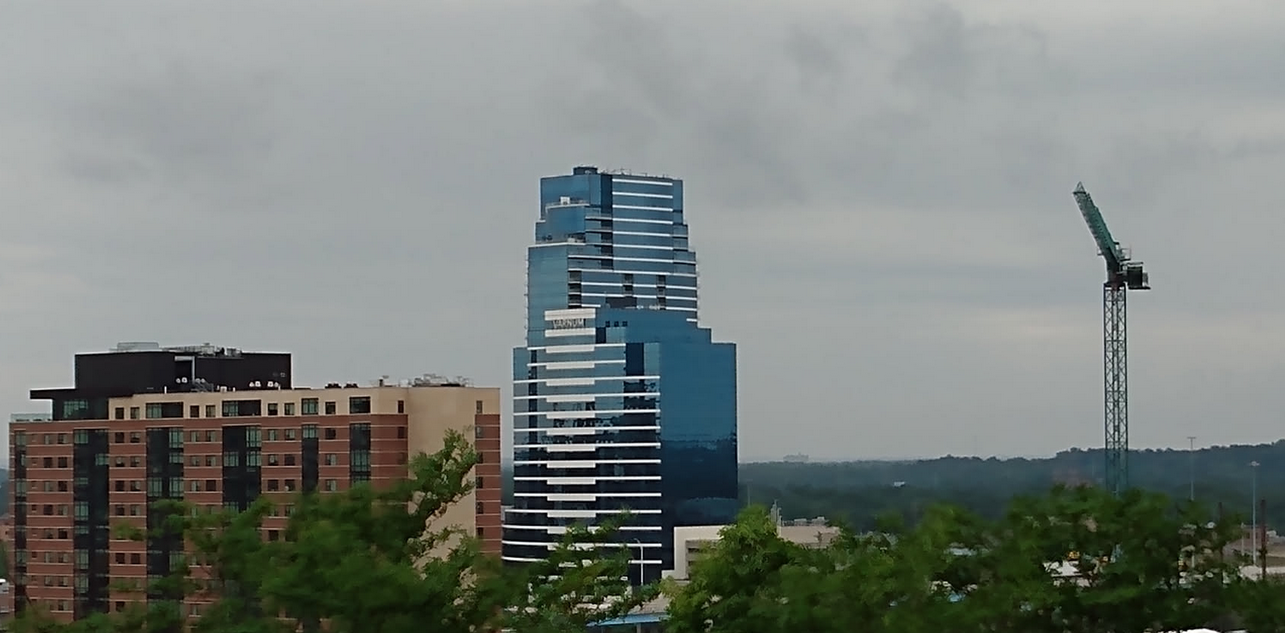 A city stands, and continues to rise, even under gray skies.
A city stands, and continues to rise, even under gray skies.
|
What now?
What can we do? Here, us.
Population growth requires three things: people (obviously), the ability of a place to receive them [aka: housing], and economic opportunity or the ability to create it [aka: infrastructure].
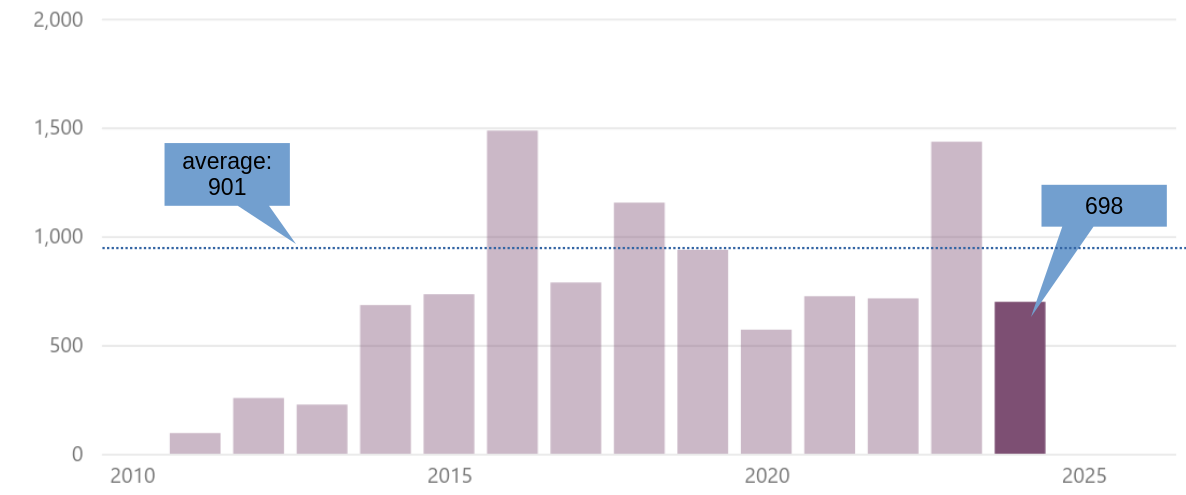 Grand Rapids Housing Production
Grand Rapids Housing Production
|
Perhaps these factors - or the absence of the ability to receive - were already suppressing growth before the darkening of the national skies.
Assuming an average household size of ~1.2 persons the 698 new homes created in 2024 only allow for 838 new citizens. Or 0.4% population growth. This is without taking into account any potential homes lost due to [re]development, fire, etc... the 698 new homes created in 2024 is likely not 698 net new homes. We are not on a path to growth, building 698 units a year. We need to build the capacity for growth; we need to build more housing.
For the last decade the City Commissions' failure to address the "housing crisis" with meaningful policy has been a factor in our anemic growth. Much economic opportunity has been lost, more accurately it has been squandered by City Commission inaction. But here we are. What we can do now is push for significant land-use reform and whatever patchwork of local investment incentives we can assemble. And we need that now, not after yet more years of study.
A new challenge created by demonstrating anemic population growth will be greater investor skepticism. Like them or not, they are who build housing, and who built most of the housing we all live in today. But we do have an untapped pool of investors: us. Making the math work is always necessary, however, some of the variables are fungible. When a neighbor invests in their neighborhood the pro-forma still needs to work, but it can work a little differently. Local investment, investment in "infill" development, is fiscally more flexible in addition to being potentially more lucrative for city (more of the transaction stays here). I built an ADU, back in 2018, and the math worked out because I was giving it more time to make the return than a traditional investor likely would, because I was also solving less quantitative problems at the same time [housing for family, storage, etc...]
- From Theory to Reality: Converting Your Home for Multi-Generational Living, Ryan Kilpatrick
- Building From the Ground Up: The Power of Small-Scale, Incremental Development, Ryan Kilpatrick
- How to Build (more) Affordable Housing, Ryan Kilpatrick
- Escaping the Housing Trap, Strongtowns (Book)
Aside: Be part of the solution; be a local investor. Sign up for Grand Rapids' first ADU Bootcamp happening this Friday (August 22nd). If you are a homeowner you likely have everything you need to be a real-estate developer at the smallest possible scale.
We can "shop local"; keep as many of our transactions, especially disposable income transactions, within the city. Need a book? Purchase it from Books & Mortar (East Hills), Cellar Bird Books (West Side), or Orchard House Books (Midtown). This may seem like an throw-away ask, but a dozen new customers is something a local business will feel. And the alternative is sending your transactions to corporations whose leadership view our communities with derision and contempt. Spend your dollars at businesses whose employees pay Grand Rapids income tax and you are contributing the operation of public transportation, contributing to the Third Ward Equity Fund, contributing the Grand Rapids Affordable Housing Fund, and helping to fund the Homeless Outreach Team.
We, locally, can invest in urban infrastructure: parks, public transportation, bike lanes, sidewalks, and our own streets. Grand Rapids has a solid history of this, we largely need to demand our leaders keep-on-keeping-on. Especially as it relates to The Rapid engaging more citizen voice is critical to breaking a growing attitude of learned helplessness from the constant grind against an uninterested state government and chronically over-subscribed and distracted local government [Grand Rapids - a city of over 200,000 citizens! - has a part-time City Commission, sometimes you get what you pay for]. The Rapids' primary source of funding - its local millage - expires in 2029. The Vital Streets tax by which Grand Rapids, unlike almost every other local government in Michigan, helps pay its own way regarding infrastructure, will also expire in 2029. These both need to be renewed, and leveled up in the case of The Rapid, in order to position our city for growth.
We, the citizens, we cannot be like the City Commission of 2016 - 2024, sitting on our hands hoping the winds will change; that someone will arrive to save us. No one is coming, not soon enough. What we have is us. We have the tools, we know what to do.
The Climate Scenario
Population cannot be discussed without a nod towards Climate Change. It is here, we are going to hit +1.5F if we have not already, +2.0F is also nearly certain. West Michigan has been described in many studies with terms like "Climate Haven". The effects will hit us, but with greater moderation than in many regions. To the preferences of many people our climate may even improve. I know that I don't mind, in recent years, being able to bike to work most weeks in December and January.
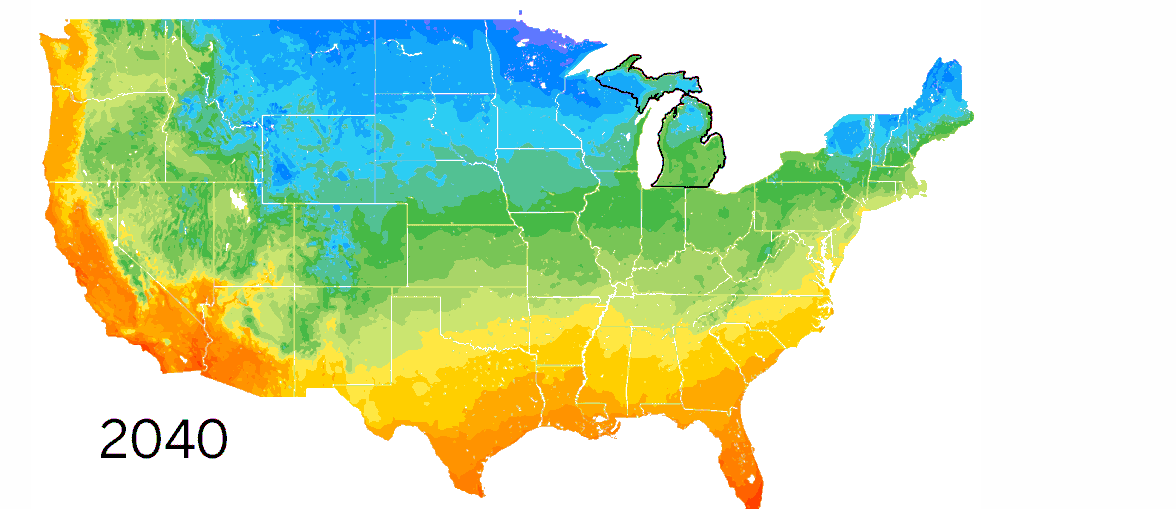 America in 2040
America in 2040
|
The Climate Migration scenario is that other regions will eventually become hostile enough to human habitation - particularly "middle class" humans - to drive migration. Some of those many people will come here. I find this scenario convincing. However, the "eventually" in the scenario is doing a lot of work. Doomed regions like the American south west (Phoenix) are still growing, and people are still building in California's WUI (Wildland Urban Interface) and on the east coast of Florida. Entire neighborhoods of Los Angeles burned, and are being rebuilt, effectively unchanged. Humans can be stiff-necked creatures; especially when the government underwrites the insurance required for poor decisions with public funds.
So, when? I have no idea. I go back to the concept of being positioned to accept growth. When that migration begins will it be better to still be floundering around in a housing crisis and depending on failing 20th century transportation infrastructure or would it be better to have the capacity to greet those climate refugees into a city with abundant and diverse housing, amenity rich neighborhoods, and a convenience and efficient transportation system? Then they will be just more neighbors and more customers.
Fortunately, even under these skies, there is no downside to making the better choices.
